Rice takes longer to cook using solar heat because the sun's energy transfers more gradually than direct stovetop flames. You'll notice solar cooking temperatures rise and fall throughout the day, especially as cloud cover and weather conditions change. While a traditional stove maintains consistent high heat, solar cooking depends on factors like the sun's intensity, which peaks between 10 AM and 2 PM, and your geographical location. Even with dark-colored pots and proper insulation, the slower heat distribution means your rice needs more time to absorb water and reach the right temperature. Understanding these solar dynamics can help you perfect your sun-cooking technique.
Understanding Solar Heat Distribution
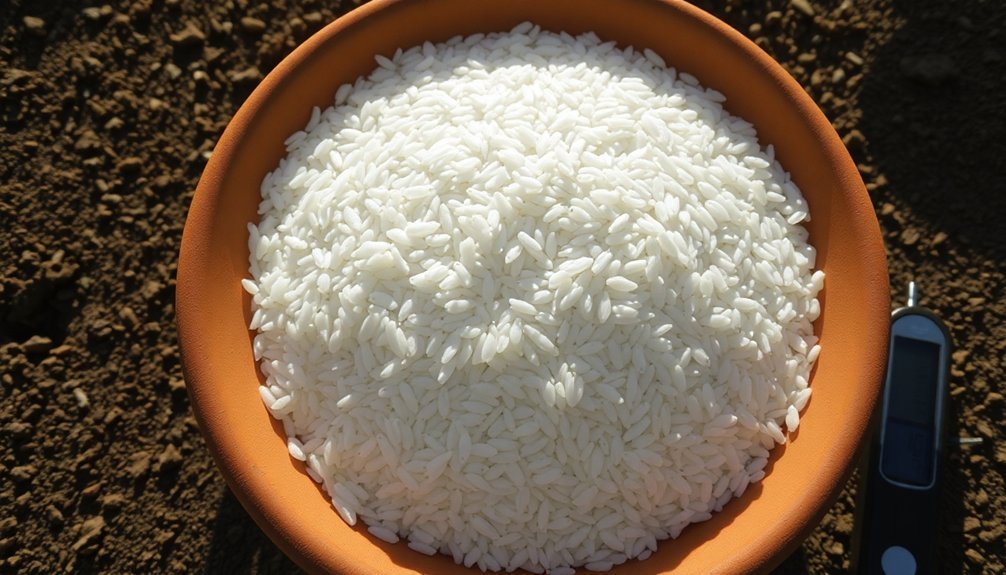
While solar radiation blankets Earth in warmth, its distribution follows distinct patterns that affect rice cultivation worldwide. You'll find that solar energy hits Earth most intensely at the equator, gradually weakening as you move toward the poles. At about 37° latitude north and south, there's a significant shift where heat loss exceeds heat gain.
Atmospheric greenhouse gases actively trap heat that would otherwise escape into space. You're dealing with multiple factors that influence how much solar energy reaches your rice paddies. Cloud cover and air pollution can notably reduce radiation levels, while the sun's angle throughout the day affects energy intensity.
Water in rice paddies responds differently than dry land, as it's got a higher heat capacity and stores energy more effectively. This means it'll take longer to heat up but will maintain temperature more consistently than bare soil.
Temperature Fluctuations in Solar Cooking
You'll find that solar cooking temperatures can rise and fall more gradually compared to conventional stovetop heating, making it crucial to understand these natural fluctuations when preparing rice.
When you're using solar energy, the heat transfer process depends heavily on factors like cloud cover and solar intensity, which directly impact how quickly your rice will reach and maintain cooking temperatures.
Your cooking times might need adjustment throughout the day as solar conditions change, requiring careful monitoring to guarantee consistent heat delivery to the rice. Cooking methods like the box cooker design work best for rice preparation since they effectively trap heat and maintain more stable temperatures.
Heat Transfer Speed Differences
Solar cooking temperatures fluctuate based on several interconnected factors that affect heat transfer speeds. When you're cooking rice in a solar cooker, you'll notice that heat transfer isn't as rapid or consistent as traditional cooking methods. This is because solar cooking relies on multiple heat transfer mechanisms working together under varying conditions.
- The sun's intensity changes throughout the day, with peak efficiency between 10:00 a.m. and 2:00 p.m., affecting how quickly heat reaches your rice.
- Wind conditions can greatly impact convective heat losses, slowing down the cooking process as your cooker struggles to maintain consistent temperatures. A well-insulated solar cooker can help maintain steady cooking temperatures regardless of outside temperature fluctuations.
- Cloud cover interrupts direct solar radiation, causing temperature drops that extend cooking time since the greenhouse effect and heat retention become less efficient.
These fluctuations make rice cooking slower but still effective with proper timing and setup.
Solar Energy Vs Direct
Understanding the differences between solar and direct heat cooking helps explain why temperature variations occur. While your stove provides consistent, controlled heat, solar cooking depends on fluctuating sunlight conditions and clear skies.
You'll notice that even with a well-insulated solar cooker that can reach 350°F, the cooking temperature constantly adjusts based on solar gain and heat losses.
When you're cooking rice, direct heat sources are more efficient, requiring only 560 kJ per kilogram compared to solar methods. Your stove's flame directly transfers heat to the pot, while solar cookers must concentrate sunlight, which degrades from 6000K to around 350K through thermodynamic processes.
While solar cooking is environmentally friendly, you'll need to account for longer cooking times due to these natural variations in heat intensity.
Thermal Consistency Challenges
While achieving consistent temperatures in traditional cooking is straightforward, maintaining thermal stability in solar cooking presents unique challenges. Your solar cooker's performance constantly fluctuates due to changing solar radiation throughout the day, with peak efficiency limited to the hours between 10 AM and 2 PM.
To understand the thermal consistency challenges you'll face when cooking rice, consider these key factors:
- Weather conditions like clouds, wind, and dust can suddenly reduce your cooker's temperature, extending cooking times.
- The sun's angle changes throughout the day, affecting the amount of radiation your cooker receives.
- Your cooker's design and insulation quality directly impact its ability to maintain stable temperatures despite external fluctuations.
These variations make it harder to predict exact cooking times, unlike traditional methods with controlled heat sources.
Rice Water Evaporation Rates
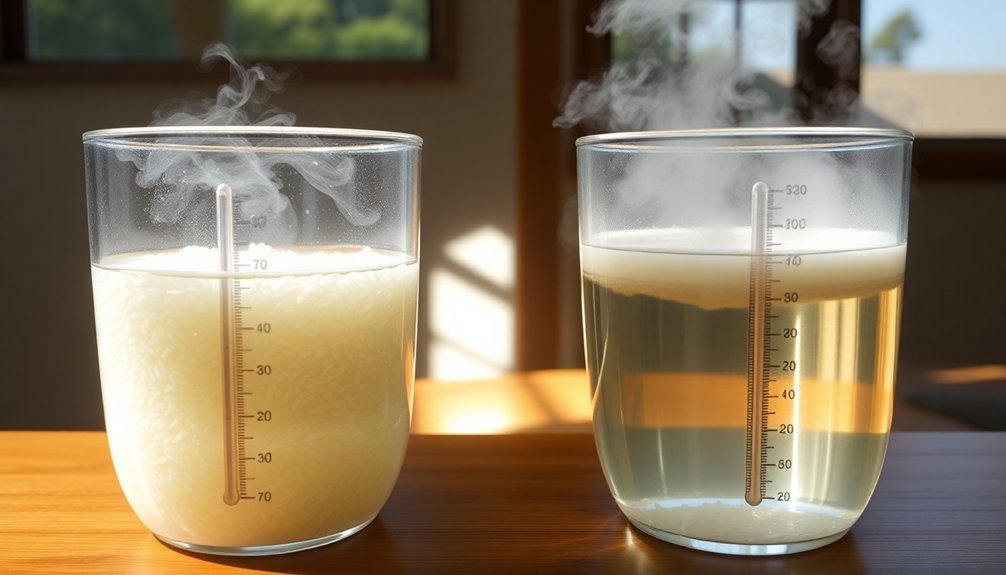
When cooking rice, you'll notice a predictable pattern of water evaporation that remains consistent regardless of volume. You'll typically lose about 1/4 to 1/2 cup of water during cooking, which is why you need to account for this loss in your initial measurements.
Your cooking environment plays an essential role in how water evaporates. The pot's sealing efficiency, ambient temperature, and humidity all affect the rate at which water escapes.
If you're seeing constant steam escape from your pot, you're losing more water than necessary. While you might think adding extra water helps, using too much (like a 1:2 ratio) will only result in mushy rice.
Instead, focus on proper lid sealing and appropriate cooking times for your specific type of rice.
Solar Cooking Equipment Requirements
You'll need three key components to effectively cook rice using solar energy: a dark-colored pot with lid, reflective materials like aluminum foil or mirror film, and proper insulation materials such as rigid foam or newspaper.
To maximize heat collection, select a matt black or enameled metal container that can fit inside a cardboard box lined with reflective surfaces and insulation.
Your setup should also include clear glazing (like glass or plastic wrap) to trap heat and cooking bags to maintain consistent temperatures around your rice container.
Essential Solar Cooking Tools
To successfully cook rice using solar energy, specific tools and equipment are essential for ideal results. You'll need dark-colored metal pots with well-fitting lids to guarantee proper heat absorption and retention. The pot should be thin enough to heat quickly but capable of maintaining consistent temperatures throughout the cooking process.
- Use cooking bags to wrap your pot tightly, as they'll help retain heat and create a steam-cooking environment that's perfect for rice preparation.
- Get a reliable thermometer to monitor your cooking temperature, remembering that rice needs 6-7 hours of bright sunlight and temperatures should remain stable.
- Don't forget proper insulation materials like rigid foam or fiberglass to protect your cooker from wind and cold, which can greatly impact cooking times and results.
Heat Collection Materials Needed
Successful solar cooking depends on gathering the right heat collection materials before you begin.
You'll need transparent materials like glass or high-temperature plastic oven bags to create the greenhouse effect that traps heat inside your cooker. Double glazing is recommended, as it considerably reduces heat loss despite slightly decreasing solar transmittance.
You'll also want to include proper insulation materials around the cooking cavity. Options like aluminum foil, fiberglass, rockwool, or even crumpled newspaper help minimize heat conduction between inner and outer box surfaces.
For structural support, choose materials like wood, plywood, or cardboard to maintain the cooker's shape.
Don't forget to add reflective surfaces, such as aluminum foil or polished metal, to bounce extra sunlight into your cooker and boost cooking temperatures throughout the day.
Proper Container Selection Tips
Selecting the right containers for solar cooking greatly impacts your cooking success and efficiency. For rice cooking, you'll want to choose dark-colored containers that absorb heat well, particularly those with matt black surfaces. Metal containers heat up faster than ceramic ones, making them ideal for cooking rice in shorter timeframes.
- Pick thin-walled metal containers that fit snugly in your solar oven – they'll heat up quickly and distribute warmth evenly around your rice.
- Use tight-fitting dark lids to retain heat and moisture, which is essential for properly cooked rice.
- Consider using cooking bags around your container to maintain consistent temperature and keep your rice warm longer.
Don't forget to preheat your container before adding rice, as this will considerably reduce overall cooking time.
Optimal Times for Rice Preparation
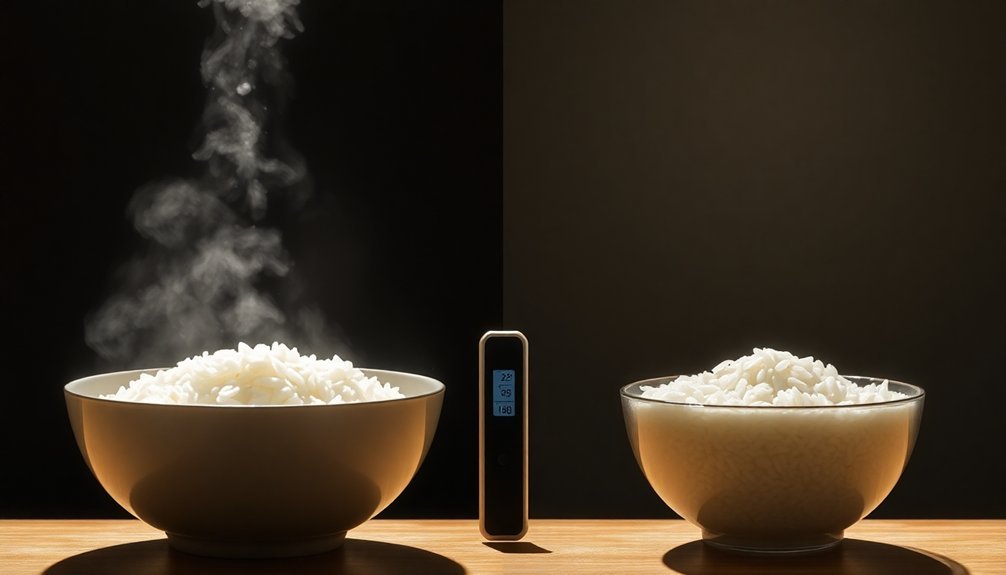
Understanding proper rice cooking times can make the difference between perfectly fluffy grains and a mushy or undercooked mess. You'll find that different rice varieties require specific cooking durations and liquid ratios for ideal results.
| Rice Type | Cooking Time |
|---|---|
| White (all) | 15-18 mins |
| Parboiled | 20-30 mins |
| Brown | 40-45 mins |
| Wild Rice | 40-50 mins |
| Instant | 5-10 mins |
To achieve the best results, you'll need to match your liquid ratios to your rice type. White long grain needs 2:1 water-to-rice ratio, while wild rice requires 3:1. Start by bringing your mixture to a boil, then reduce heat and simmer. Remember to keep the lid on tight and resist the urge to peek, as this releases essential steam needed for proper cooking.
Managing Direct Sunlight Exposure
While mastering rice cooking times helps create the perfect dish, proper storage is just as important for maintaining rice quality.
You'll want to protect your rice from direct sunlight exposure, as it can lead to temperature fluctuations that compromise both quality and safety.
To effectively manage sunlight exposure, follow these key practices:
- Store your rice in airtight containers and keep them in cool, dry locations between 15-25°C (59-77°F).
- Choose storage spots away from windows, stoves, and heating vents to maintain consistent temperatures.
- Consider refrigeration if you're in a warm climate, as it can extend your rice's shelf life.
If you notice any signs of spoilage, such as unusual odors, slimy texture, or discoloration, it's best to discard the rice immediately to prevent potential foodborne illness.
Weather Impact on Cooking Duration
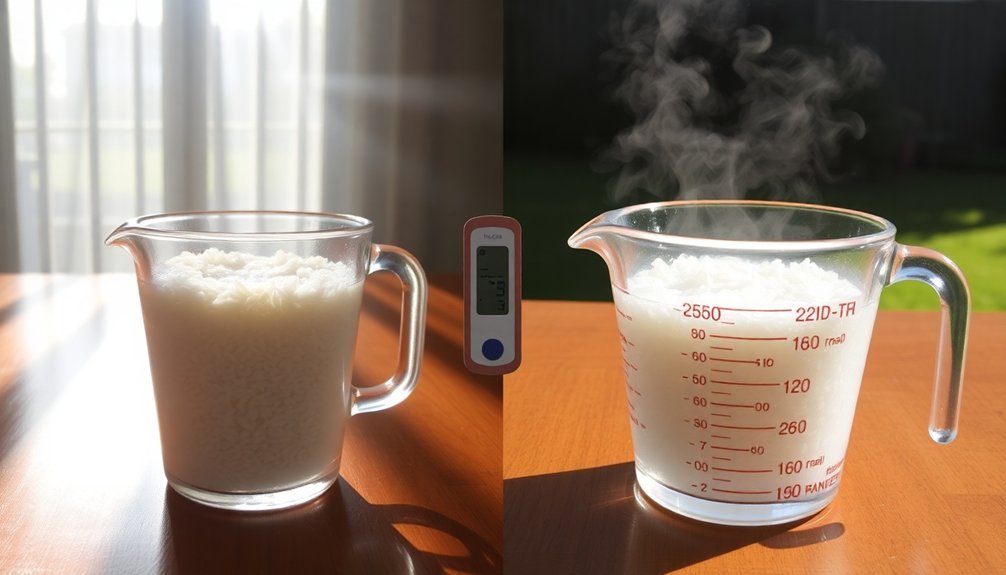
As weather conditions fluctuate throughout the day, they greatly influence how long it takes to cook your rice perfectly. Higher temperatures accelerate chemical reactions in cooking, but humidity can slow down evaporation, creating a complex balance you'll need to take into account.
You'll notice that your rice might take longer to cook when it's humid because moisture can't escape as efficiently. Wind speed also plays an important role – stronger winds can affect heat transfer rates, potentially extending cooking duration.
The Wet Bulb Globe Temperature (WBGT) helps you understand these combined effects, as it accounts for temperature, humidity, wind speed, and sunlight exposure. When WBGT values are high, you might need to adjust cooking times and take safety breaks, which can further extend the overall duration of your rice preparation.
Rice Varieties and Solar Timing
Because each rice variety absorbs water differently, you'll need to adjust your solar cooking approach accordingly. Your cooking time will vary based on both the rice type and your solar cooker's efficiency.
Basmati and jasmine rice cook faster in a parabolic solar cooker, taking just 20-30 minutes, while short-grain varieties need 6-7 hours.
- For short-grain white rice, use a 1:1 water ratio and expect longer cooking times due to its dense structure.
- Medium and long-grain varieties need more water (1:1.5 to 1:2 ratio) and may require additional time to absorb properly.
- If you're using arborio rice, be prepared for extended cooking periods as it can absorb up to six times its volume in water.
Remember to adjust your reflectors throughout cooking to maintain ideal sun exposure.
Steam Generation Under Solar Heat
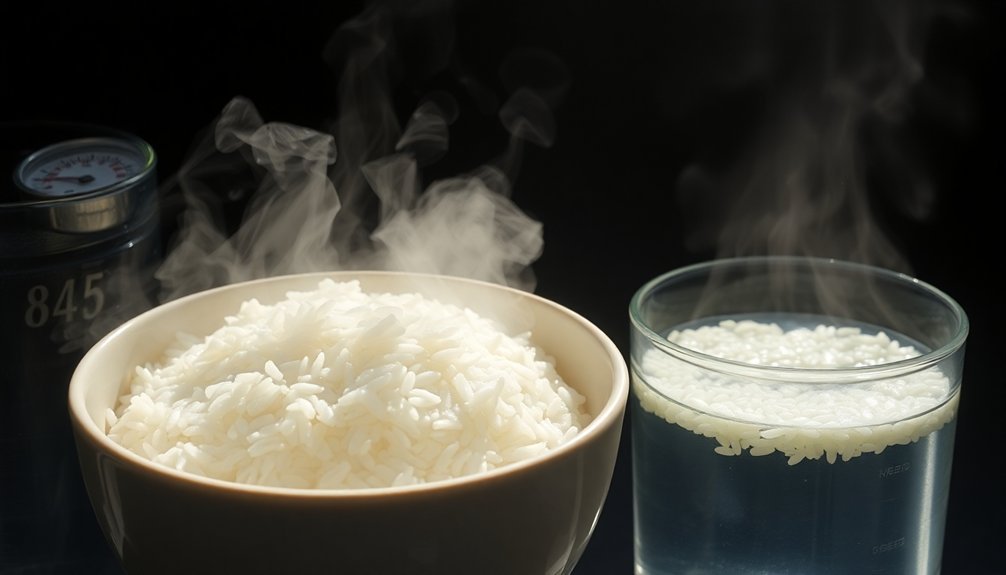
When you're managing rice under solar heat, you'll notice distinct heat distribution gradients that affect how steam develops throughout the cooking vessel.
You'll need to account for steam loss patterns, which can vary based on the container's design and the intensity of solar exposure.
The pressure development challenges you'll face depend largely on your ability to maintain consistent heat across the cooking surface while preventing excessive steam escape.
Heat Distribution Gradients
While solar cooking relies heavily on efficient heat absorption, understanding heat distribution gradients proves essential for ideal steam generation. You'll notice that heat doesn't spread evenly throughout your solar cooking pot, which affects how quickly rice can absorb water and cook properly.
The way heat moves through convection, conduction, and radiation creates varying temperature zones that impact cooking performance.
- Thermal energy storage materials like oils and PCMs help balance these gradients, but they'll still perform differently than traditional stovetop heating.
- The pot's design, including finned surfaces and material choice, impacts how effectively heat spreads from the bottom to the top.
- Air flow patterns within your solar cooker create unique convection currents that affect temperature distribution, making rice cooking times less predictable than conventional methods.
Steam Loss Patterns
As solar heat drives the cooking process, understanding steam loss patterns becomes critical for efficient rice preparation. You'll notice the greatest steam escape during the final cooking phase when temperatures hit 100°C, with each gram of escaping steam taking away 2,200 joules of energy.
| Steam Loss Factor | Impact on Cooking |
|---|---|
| Lid Usage | Reduces energy waste by 40.3% |
| Pressure Control | Raises cooking temperature, cuts time |
| Temperature Level | Keep at 100°C for maximum efficiency |
You'll get better results by avoiding vigorous boiling, as it doesn't speed up cooking but instead wastes energy through excessive steam loss. Using a pressure cooker can help minimize these losses while maintaining higher cooking temperatures, considerably reducing your cooking duration compared to standard solar cooking methods.
Pressure Development Challenges
Despite solar cooking's eco-friendly appeal, generating sufficient pressure for efficient rice cooking presents distinct challenges. You'll notice that lower-powered heating elements, typically around 300W for solar systems, extend your cooking time considerably. When you're relying on solar energy, inconsistent sunlight can further complicate pressure development.
To overcome these pressure challenges, you'll need to take into account:
- Temperature management – reaching and maintaining 120°C requires proper insulation and heat storage.
- Power optimization – matching your solar panel configuration to your cooker's 24V DC requirements.
- Heat retention solutions – incorporating phase change materials like erythritol to store solar energy for continuous cooking.
Using evacuated tube collectors and ensuring unobstructed panel positioning can help you achieve better pressure development. However, you'll still need to account for longer cooking times compared to conventional methods.
Adjusting Traditional Rice Recipes
Traditional rice recipes often need adjusting based on your specific rice variety and cooking conditions. You'll need to take into account factors like starch content, cooking liquid temperature, and heat management to achieve perfect results.
| Adjustment Factor | What You'll Need to Do |
|---|---|
| Rice Type | Match water ratio to grain length |
| Liquid Temp | Warm cooking liquid to room temperature |
| Heat Control | Start high, reduce to simmer after boil |
| Resting Time | Let sit 5-10 minutes, then fluff |
If you're using long-grain rice, you'll need more water and cooking time than short-grain varieties. Don't forget that adding stock or fats will affect your cooking time and temperature needs. When you're working with enriched rice, you'll want to minimize rinsing to preserve nutrients. Remember that proper heat management is essential – keep that lid on and let it simmer.
Solar Energy Absorption Methods

Solar energy absorption involves multiple methods to harness the sun's abundant power, with modern systems capturing up to 71% of incoming radiation.
When you're cooking rice under the sun, you're actually experiencing a complex energy conversion process where sunlight causes molecules to vibrate faster, increasing temperature.
Modern solar absorption systems use three main approaches:
- Photovoltaic cells that directly convert sunlight into electricity through internal electrical fields
- Concentrated solar-thermal power that uses mirrors to focus sunlight and generate steam
- Advanced absorber materials that optimize wavelength absorption while minimizing heat loss
These technologies demonstrate why traditional rice cooking under direct sunlight isn't efficient – it lacks the controlled energy conversion and concentration mechanisms that make modern solar systems effective.
The sun's energy gets scattered and partially reflected rather than being precisely directed for cooking.
Frequently Asked Questions
Can Solar-Cooked Rice Maintain the Same Nutritional Value as Traditionally Cooked Rice?
You'll find solar-cooked rice actually maintains better nutritional value than traditionally cooked rice, as it preserves more water-soluble vitamins and minerals while keeping the natural starch structure largely intact through gentle heating.
Does Altitude Affect Solar Rice Cooking Time Differently Than Conventional Methods?
You'll find that altitude affects solar rice cooking less dramatically than conventional methods since solar cooking doesn't rely on boiling point. However, you'll still need more liquid and time at higher elevations.
How Does Rice Color Influence Solar Cooking Absorption Rates?
You'll find that rice color doesn't greatly impact solar cooking absorption rates. Instead, it's your pot's color that matters most – dark-colored pots absorb heat better, regardless of whether you're cooking white or brown rice.
Can Moonlight Reflection Be Used to Continue Rice Cooking Overnight?
No, you can't use moonlight to cook rice overnight. The reflected sunlight from the Moon is far too weak to generate any meaningful heat needed for cooking. You'll need a proper heat source instead.
Do Electromagnetic Fields From Nearby Power Lines Affect Solar Rice Cooking?
No, you don't need to worry about power line electromagnetic fields affecting your solar rice cooking. They have no impact on the cooking process, which relies solely on solar thermal energy and proper insulation.
In Summary
You'll find that rice takes longer to cook under solar heat due to inconsistent temperature control and slower steam generation. While traditional stovetop methods maintain steady heat, solar cooking experiences fluctuations throughout the day. You'll need to adjust your cooking times and water ratios accordingly. For best results, you should start early in the day when solar intensity is highest and consider using a well-insulated solar cooker.





Leave a Reply